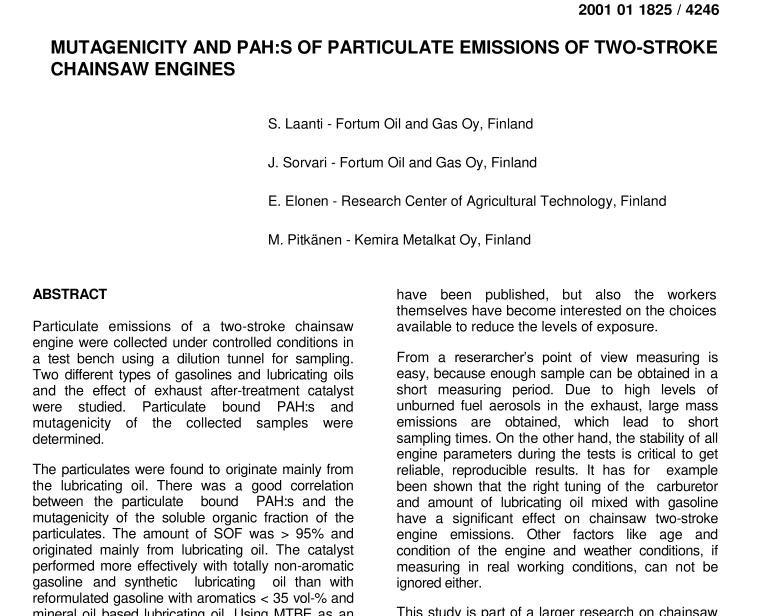SAE 1825:2001 pdf download Mutagenicity and PAH:s of Particulate Emissions of Two-Stroke Chainsaw Engines
Taking into account the amount of particulates, their SOF-content and certain instability in running a 2- stroke chainsaw engine, a minimum runtime of 10 minutes on idle or 5 minutes on full throttle was used in the tests. In future work a shorter sampling period could be recommended in order to avoid too wet filters.
Good correlation was found between the particulate bound PAH:s and the mutagenicity of the soluble organic fraction. The samples with highest amounts of PAH, both total and 5&6-ring PAH:s gave the highest indications of mutagenicity in Ames-test. The mutagenicity results obtained in parts 2 and 3 can not be directly compared with each other because of different levels of response of the bacteria in the two series. The results should only be compared within the same series, where the measurements are done in sequence. The PAH compounds measured in parts 1 to 3 can be compared with each other.
Higher mutagenic responces with nitroreductase containing tester strain YG 1021 versus TA-98 without metabolic activation revealed the presence of nitro-PAH compounds in the chainsaw exhaust.
There are no samples significantly differing from the order found with TA-98. This means there are no fuel combinations especially forming relatively more nitro-PAH:s.
The mutagenicity results obtained with metabolic activation were roughly in the same relative order as they were without S9. Higher responses with metabolic activation than without S9 indicated of indirect acting compounds. In other words there were compounds, which can turn into mutagens in mammalian metabolic system. There is still work to be done on using S9 and improving the accuracy. At this point no more conclusions on the results with S9 can be made.
In summary the best combinations were reached with the aliphatic, no aromatics containing gasoline Futura Green with either of the lubricating oils. When this gasoline was oxygenated (Futura Green Oxygenated), the results were good even without catalyst, and when not oxygenated (Futura Green), with the aid of catalytic aftertreatment. Contrary to our results Magnusson et al. / 5 / didn’t find a positive correlation between PAH:s and mutagenicity.
They also found less mutagenic affect when using metabolic activation than without (-S9). On the other hand, in accordance with our results was their conclusion, that gasoline had more effect on the PAH-content than did the lubricating oil. However, according to them the role of lubricating oil on PAH emission became more significant when using gasoline with low PAH content. The gasolines applied here were both very low in PAH:s and Futura Green contained practically no aromatics. In the ester based lubricating oil there are no PAH:s. The PAH:s are formed in the combustion process and both the gasoline and the lubricating oil have an affect on the PAH composition of the exhaust. MTBE in Futura Green gasoline had a significant effect on reducing the PAH emissions. Clearly the effects of the gasolines were somewhat overshadowed by the effects of the lubricating oils and vice versa.
SAE 1825:2001 pdf download
